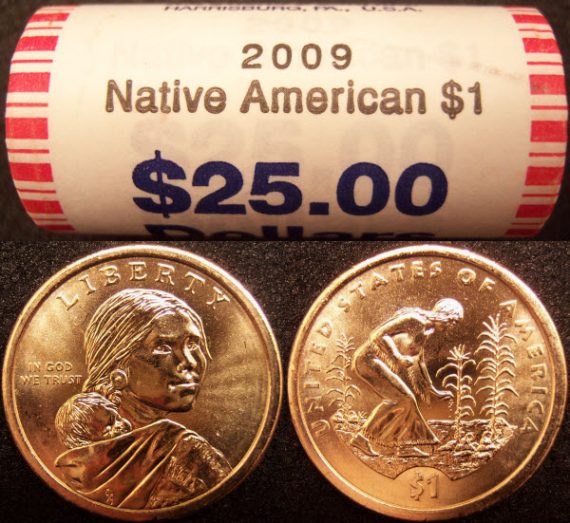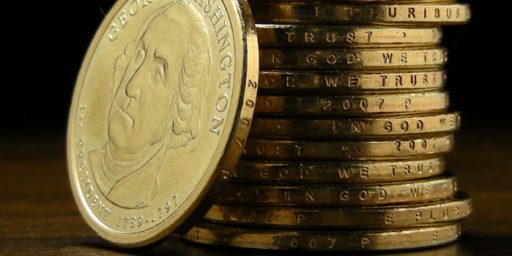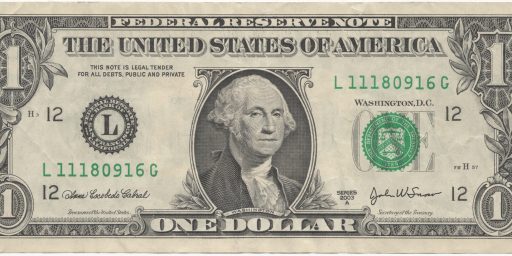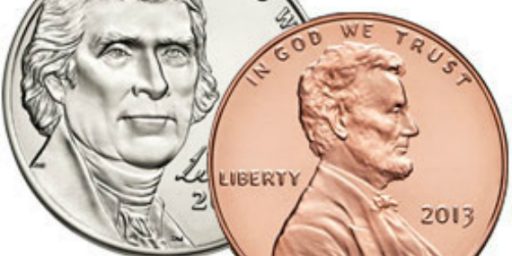Why Dollar Coin Failed
Why didn't the government simply stop printing new dollar bills, making transition to coins non-optional?
Stan Collender, who led the consulting team that advised the Mint on the creation of a new dollar coin a decade back, explains why the Sacagawea dollar failed despite high public approval. It’s a long, complicated story that defies excerpting; I recommend you read it in full.
The short version is that it is expensive for banks, retailers, vendors and others to make the transition from bills to coins and that, while consumers expressed a preference for coins, they don’t care all that much.
What I’ve never understood is this: Why didn’t the government simply stop printing new dollar bills, making transition to coins non-optional?







Exactly. I prefer a dollar coin over the bills since most vending machine items nowadays are about $1 or more. I really like the countries I visited which used single denomination coins instead of bills (Canada, UK, Euro, etc.) Make so much more sense, really. The attachment to the bill is more nostalgic than anything else. The US is always much more conservative about keeping old systems in place long after everyone else, like the English measurement system.
It really is just a matter of infrastructure. No place for dollar coins in the cash registers. Doing away with the paper dollar doesn’t open up space along the front coin bins either. Not to mention, carrying 10 one dollar coins is much heavier than carrying 10 one dollar bills.
During the Clinton Administration, I worked for Commerce. Then Secretary, Ron Brown, issued an edict that Commerce was going all metric. All well and good, but they never found the money to buy new file cabinets. Metric sized paper is larger than US standard and therefore won’t work in file cabinets and, at that time, many paper trays built for US standard paper. Simple as that. Fortunately, I believe all new file cabinets and paper trays are set up to handle metric or US standard but the US government has a whole lot of legacy file cabinets.
Absolutely, James. It wll work only when the paper bills are declared worthless. In 1988, Belgium had a 50-franc note (about $1.25). They started circulating coins, and quit printing notes. A year later, the bills were declared worthless, no one had to honor them, EXCEPT the banks. The banks would accept them for deposit, or exchange for the new coins. But all the bills lost ALL of their value six months after that. How I dearly wish the US would do the same.
My attachment to the dollar bill is purely practical, DCL. If I have to pay for an item with a $5 bill, I’d much rather get four $1 bills in change than four of those big honkin’ coins, weighing down my pocket and contributing to an annoying jingle. I dump my change ASAP when I get it, but I’d have to hold on to $1 coins because $5 is too coarse a division for the smallest value of currency in my pocket at any given time.
While I acknowledge the higher cost of bills, we don’t (and shouldn’t) always race to the lowest common denominator in order to save money. We pay for convenience all the time, and (solely in my judgment, of course) the convenience of a bill far outstrips its relative cost.
As pointed out in the linked post, the bills aren’t discontinued because the paper providers prevail upon their Congressional delegates to circumvent it. He specifically mentions legislation introduced by Sen. Kerry, whose state holds one of the largest currency paper manufacturers. Loss of the dollar bill would put a big dent in their bottom line and it isn’t like they can sell their excess elsewhere.
@JKB: Ah, I actually glossed over that. Bizarre that one Senator would be able to hold this up, though, but stranger things have happened.
Stan’s credibility as an “expert” who who competently understands how the world works just took a massive hit …
Make the dollar coin the size of the quarter, make the quarter the size of dime, make a nickle the size of a penny — and eliminate the penny.
Yes, I am a genius.
Stan, clearly, is not.
The inability of the American ruling class to produce coins that make sense is one of the great symbols and the incompetence of that class …
OTOH, they make excellent ball markers on the golf course. Also the Susie B.
@JKB:
Metric is a system of measurement, and does not have a paper size.
Now, I assume you mean that Commerce wanted to go to some European standard paper sized, which was most commonly measured in metric dimensions. But that’s different.
(I agree it’s time to end the paper dollar.)
@john personna:
I was watching Top Gear the other night (the Brit version, not the awful US version), and one the guys said, “That’s 10 yards, or 9 something meters in Catholic.”
You know why I didn’t use the dollar coin (besides vending machines not taking them)?
Because they were almost the exact same damn size as the quarter. Do you know how aggravating it is to think you’re throwing in a few dollars into free museum’s charity box and then realize you threw in $10?
(And while I may sound like a miser here, that museum was really pretty horrible and did not deserve $10 by any means)
(And yes I realize the argument could be made that if more people threw in $10 instead of $1.00 that the museum might become better. I don’t care.)
@samwide:
Yeah, those guys keep a good stream of metric jokes.
BTW, if you eliminate the penny at the same time you transition to a dollar coin, that would seem to help the tray-redesign problem. Or at least, you can kill both birds in one redesign.
(I wouldn’t shift sizes as Greg suggests though, I find the current quarter and dollar to be fine.)
I like coins, but they can get to be too much. I wore holes in more than a few pockets carrying around British Pound coins. I suppose that’s my change-management problem, but I always have at least a couple of bucks worth of coins in my pocket and use them to pay exact prices.
I wouldn’t mind losing the penny or the dollar bill.
@Neil Hudelson: I was sure the Sacagawea was larger than the Susie B, but research indicates they were exactly the same diameter. I’m glad that I checked my facts before I posted, for once.
@Boyd: I’ve yet to see the Presidential Dollar coins. Are they the same size, too?
@Boyd: Never mind. I just checked Wiki. Same size and weight; different composition.
We lived in Canada for a year, and I actually quite liked the system–but to Boyd’s point about weighing down pockets, you really need to have $2 coins as well as $1 coins to make it work. And to samwide’s point, a “toonie” is a great ball marker.
The way the $1 coins were launched in the U.S. was just foolish. I remember using a $10 bill to buy stamps in an automated machine and getting 9 dollar coins in return…which were useless when I realized I needed another stamp and the machine wouldn’t accept the $1 coin.
It’s like this, ever try carrying a dozen dollar coins in an already heavy purse? I’ve done so with the pound coin. It was a pain. If you think I’m going to carry fifteen or twenty impossibly heavy coins in my purse that has everything but the kitchen sink and the cat box, I have a bridge in Brooklyn that is on sale – cheap.
Ten – twenty singles weigh nothing. Enough said.
It’s a chick thing.
SJR
The Pink Flamingo
In Canada, the loonie and the twoonie (one and two dollar coins) are extremely handy – light, easily distinguishable from quarters, and very practical for parking meters and the like. The rumor I heard is that they were pushed by the gov’t for exactly that reason … parking meters and transit. In any case, they caught on right away simply because they were more practical than having a wallet full of one dollar bills.
Maybe it was just a question of the actual design used for the American dollar coin that caused it to fail?
What would be the impact on strippers? More $5s? Fewer tips? Wear a change bucket?
I don’t want to carry 10 or 15 dollar coins around all the time. They are too heavy and too inconvient.
@SJ Reidhead: Impossibly heavy? Please.
Like has been mentioned earlier, create a $1 and a $2 coin at the same time, phase out the penny and nickel and dollar bill, and you’re done. As long as your $2 coin weighs less than two $1 coins, and your $1 coin weighs less than, say, 3 quarters, a dime, a nickel and four pennies, then I don’t see what all the complaining is about.
For instance, in Canada:
Penny: 2.35 grams
Nickel: 3.95 grams
Dime: 1.75 grams
Quarter: 4.4 grams
Loonie: 7 grams
Toonie: 7.3 grams
If you bought something that cost $1.02 and you still had a penny in play, then you’d get 98 cents in change, and it’d weigh, at a minimum, 23.75 grams. If we got rid of the penny (and nickel, but that’s not at play in this example), the price would be rounded down and your change would be $1, which would weigh 7 grams. Less than a third the weight.
Sure, dollar bills weigh less. Which is why pairing this with the elimination of nearly worthless coin denominations like the penny and nickel makes it, on the whole, a better deal.
Just ran some quick numbers on a few scenarios. I ran the weight on every amount of change from 1 cent up to $10 using the current (US) system, where bills weigh 1 gram, and the rest are the following:
Penny: 2.5
Nickel: 5
Dime: 2.268
Quarter: 5.67
Dollar Coin: 8.1
Notional Two Dollar Coin: 8.5
I got that 8.5 gram weight for the two dollar coin by just making it have roughly the same proportion to the one dollar coin as Canada’s toonie has to its loonie.
Basically, on average, adding dollar coins with no other changes adds weight on average. This much is clear. Adding two dollar coins in addition to one dollar coins mitigates this. Eliminating pennies reduces weight across the board, and then adding dollar coins to that system increases weight, and adding two dollar coins mitigates this.
If we were to adopt a system wherein we eliminated the penny and nickel (and rounded to the nearest 10 cents; I could have played it where we also round to 25 and 75 cents, since quarters are in play, but for these purposes I didn’t), and adopted $1 and $2 coins, and kept $5 and $10 bills, the average weight of change from 1 cent up to $10 is less than 1 gram heavier than our current baseline. That’s less than half the weight of a dime. The weight issue, if we handle it correctly, is really a non-issue.
I’ve been living in Canada for years, and I don’t think I’ve ever heard a single person complain about the weight of coins – not even your proverbial little old ladies. It’s really not an issue, unless I suppose you either were seriously ill (in which case you probably would be bed ridden anyway), or liked to walk around with hundreds of dollars in small denominations (ie $1 dollar bills) instead of fives, tens, and twenties.